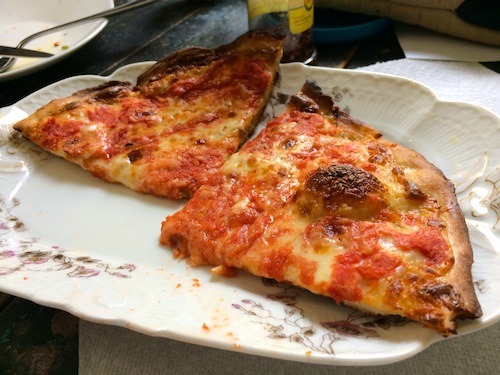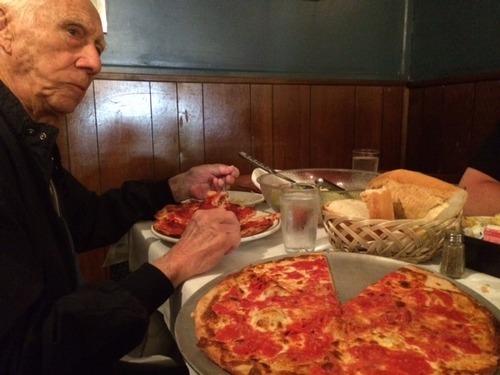
Michael in front of his toaster oven as it reconstitutes treasures from his youth.
There’s something so special and untouchable about the pizza you grow up eating. Every Sunday night you’d gather with family at the same restaurant and order the same dishes and eat them the same way. You’ll eat better pasta, better chicken marsala and better pizza in your life but somehow it will never make you feel the same as those family get-togethers. Sunday nights were particularly special for my friend Michael Berman, who would spend them at a restaurant called Pines of Rome in Bethesda, Maryland. Michael is a fantastic photographer, recent author of a great book about things to do in NYC with kids, AND he runs an excellent blog called PizzaCentric. I was deeply honored when Michael invited me to his Brooklyn abode to share some of the pizza he carefully transported back from his favorite pizza restaurant in Bethesda after a Memorial Day weekend visit.

Actual conversation between two adult males about pizza transportation.
I tried to visit Pines of Rome on Michael’s recommendation when I was in Washington, D.C. a few months ago. I got there 30 minutes before closing time but the pizza guys had already gone home, leaving me with a consolation prize of eggplant parmigiana, which I ate on the bench out front. I knew in my heart that one day I would make good on my blood oath to Michael to eat his favorite hometown pizza.

As much as I do love eating great pizza, I’m far more interested in the story behind it. One taste of a slice, even one that has been reheated, paints a portrait of the pizzeria itself. This is an Italian-American restaurant in its most classic form. Bread is served in baskets, the walls are lined with faux wood paneling, salads are served in textured plastic bowls and accompanied by an oil-and-vinegar caddy. Pizza is available, but it’s not based on an ancient family recipe. This is pizza that fills a void on the menu. Not to say it isn’t delicious – because it IS – but it has been cast as a supporting actor rather than the lead.
Michael showed me a great video of the pizza-making process that confirmed my expectations. Doughs are pre-rolled and topped with slices of low-moisture mozzarella. When an order is placed, sauce and toppings are added and the pizza bakes in the pan for a few minutes. Nothing artistic, just the basic definition of Italian American restaurant pizza.

Michael’s 95 year old grandfather enjoying the Sunday ritual.
The experience of eating this pizza in Michael’s kitchen was beautiful. Maybe it would have tasted better in the restaurant, but that really didn’t matter. I could see that sharing it with me was for Michael what religion is to some people. He asked me if this pizza was truly as brilliant as he always thought it to be or if it was just the attachment to his youth that made him love it so much. I started thinking about my own childhood pizza and how I have long since come to terms with the fact that it isn’t very good. But does that really matter? Do we need to separate emotion from flavor? In a food culture that’s getting more judgmental every day, I truly hope that separation never happens.

